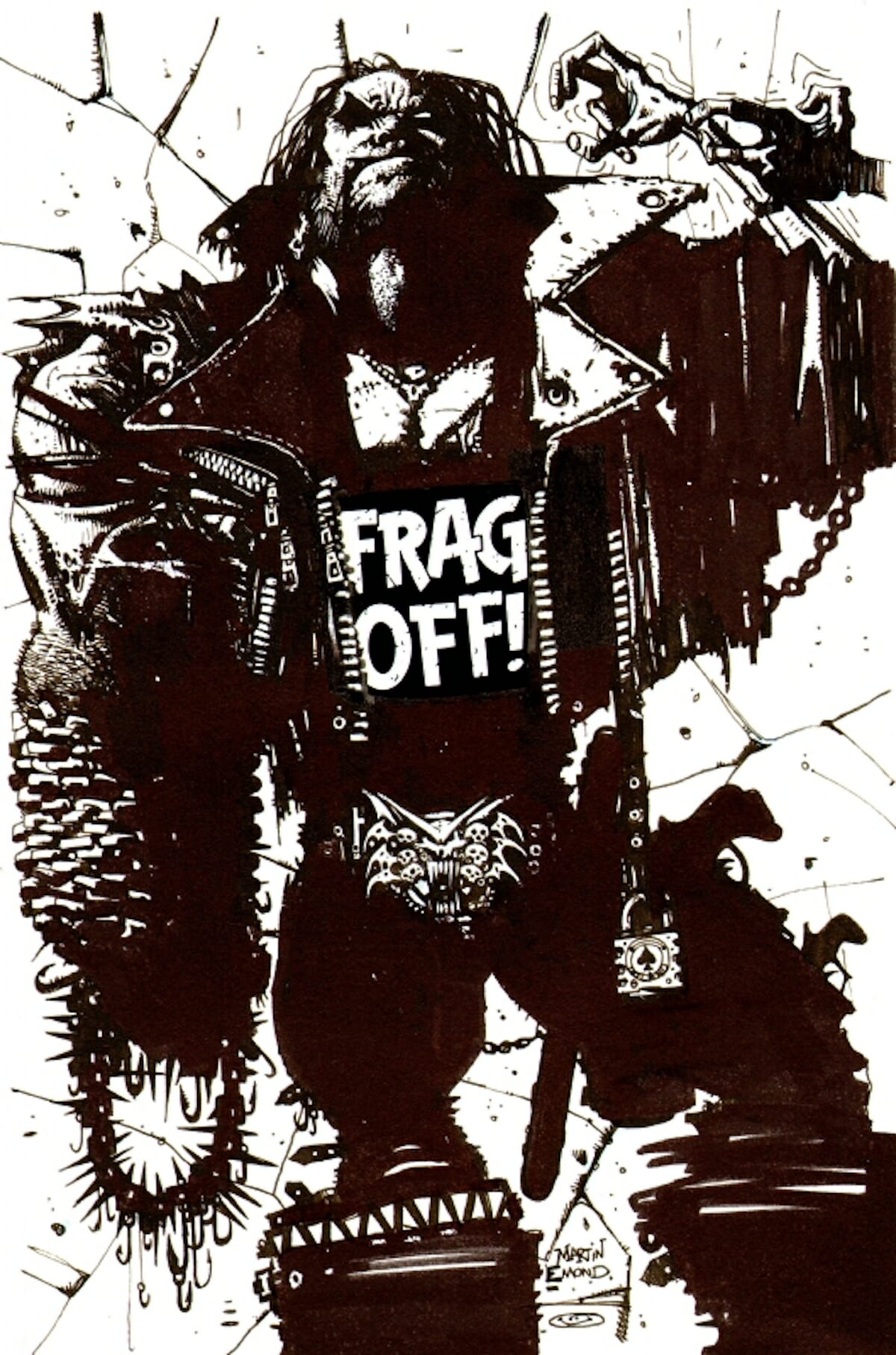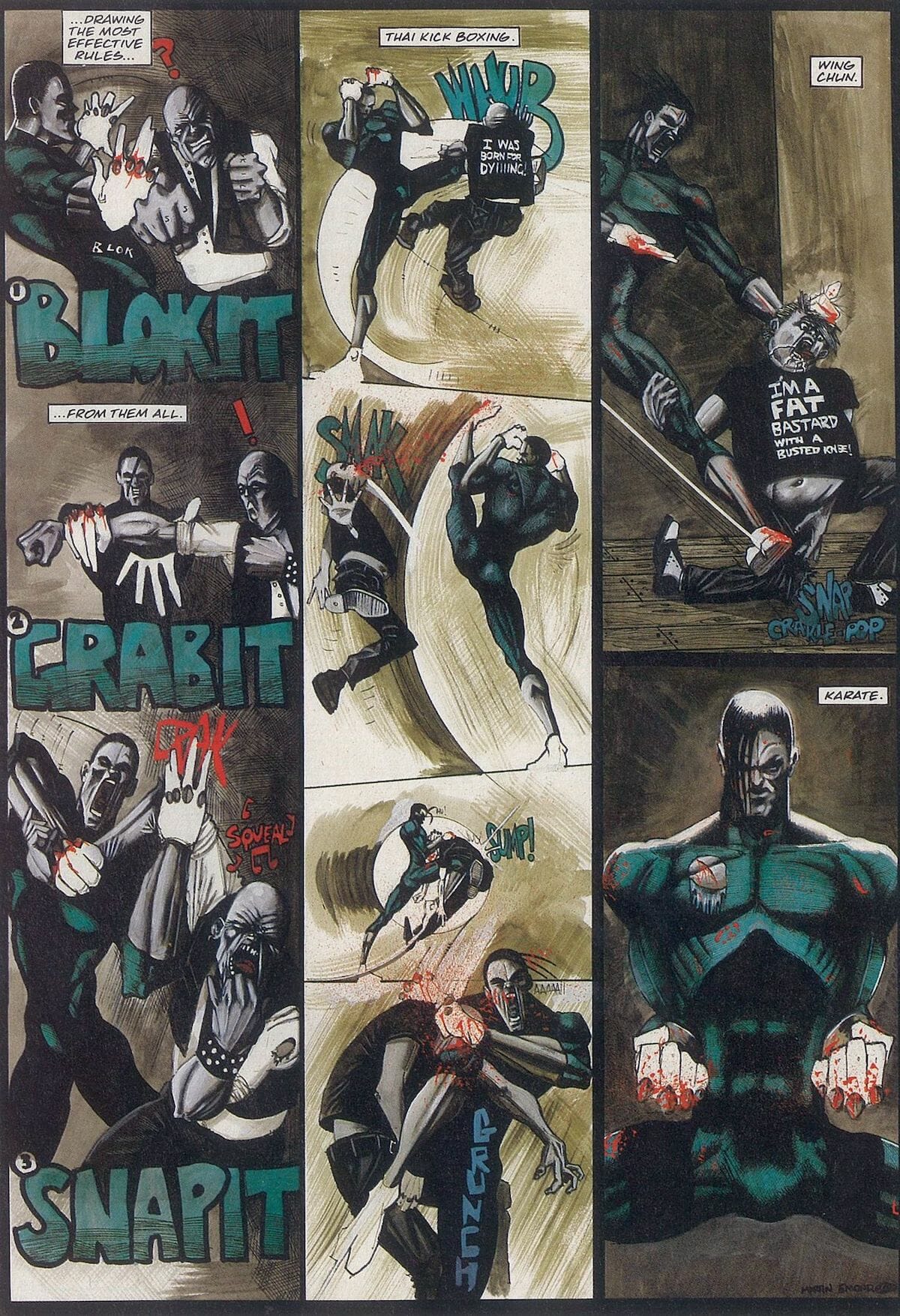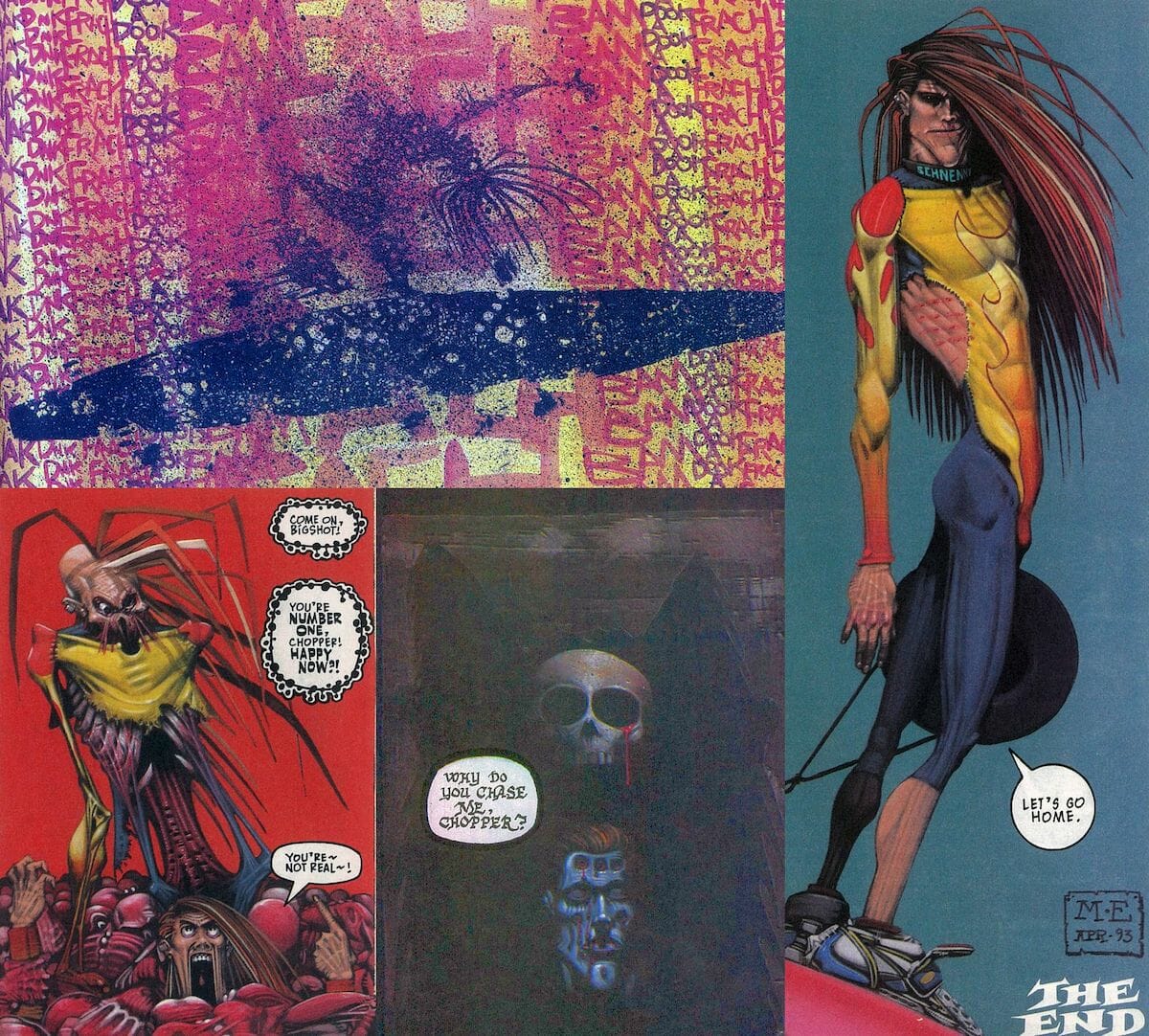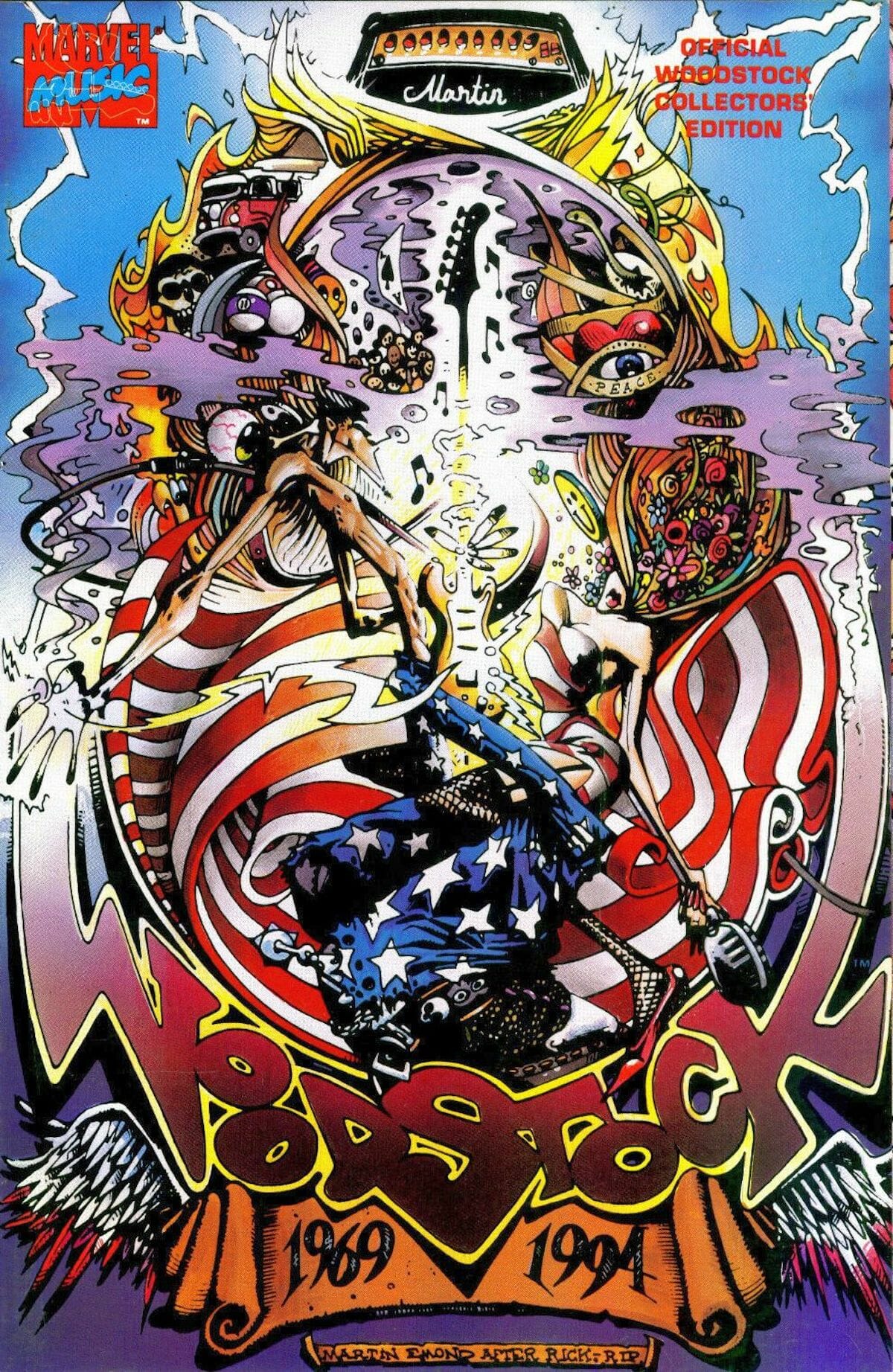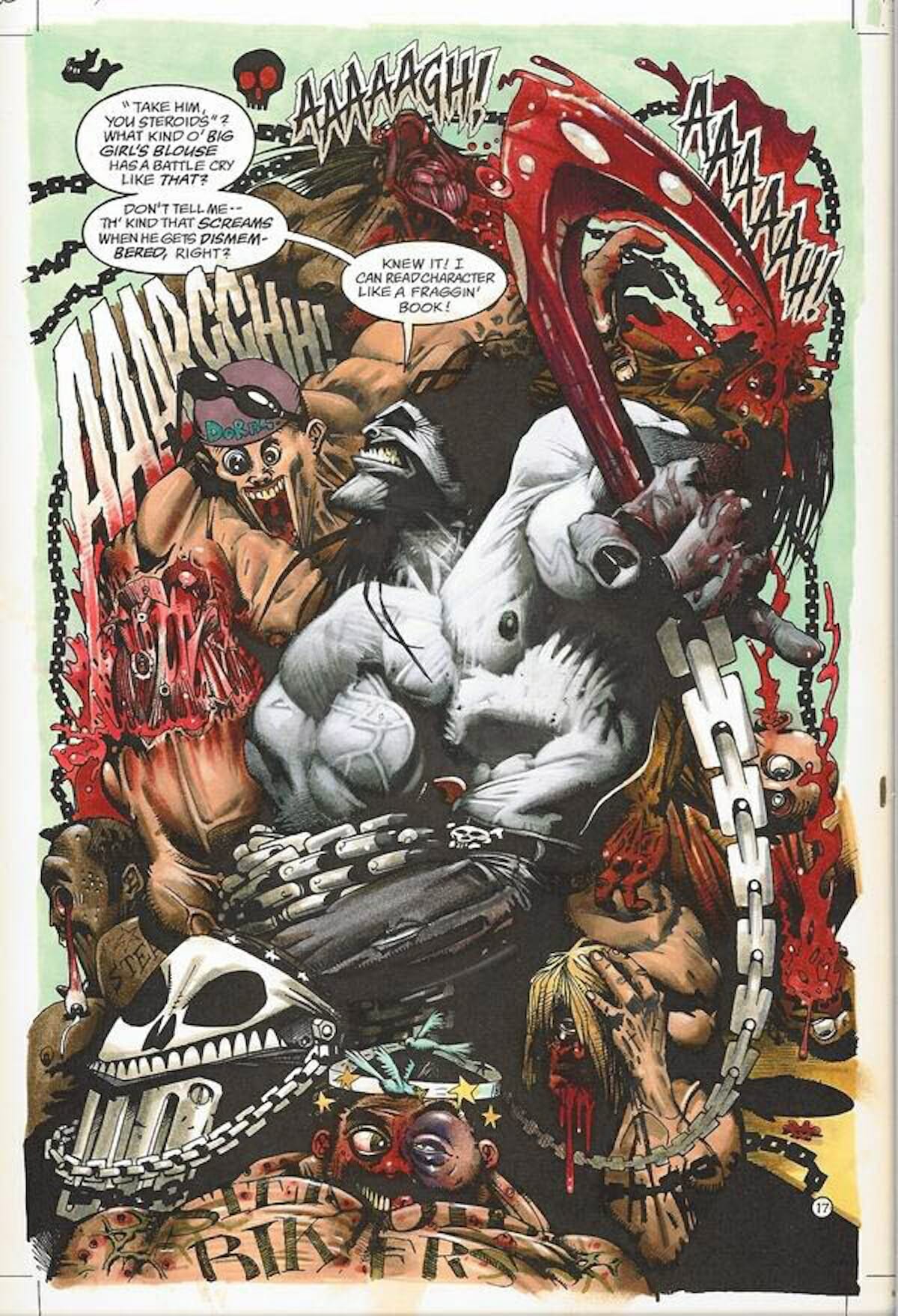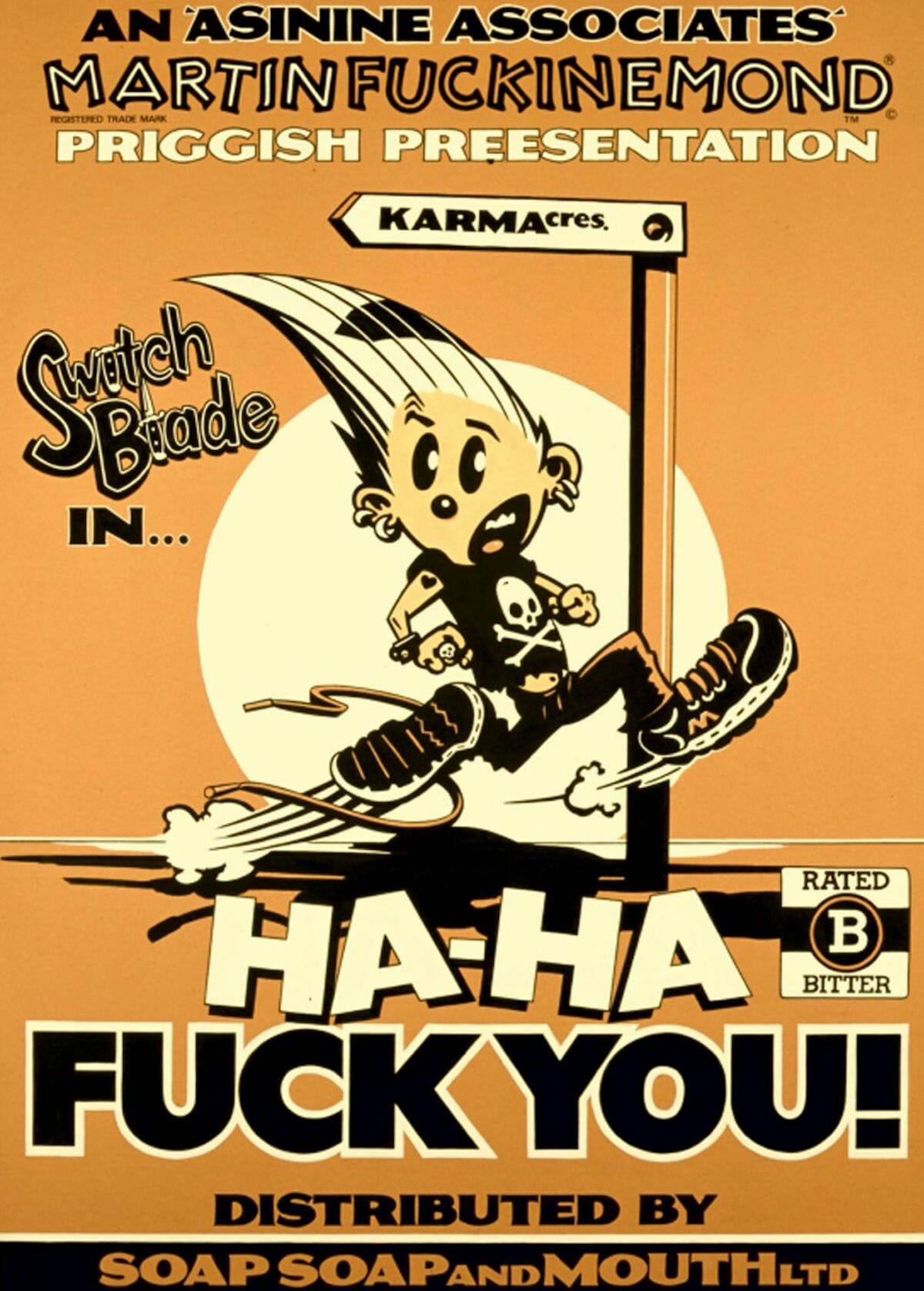Martin Emond didn’t want to be remembered just as a comic artist. He had a massive Calvin tattoo on his back, but the Kiwi artist thought comics were for geeks.
In his painfully short career as a working artist, Emond did do some fantastic comics, but he was an all-round incredible illustrator; having done gig posters and album designs – both for his own band Flame Job and for other local bands – and created designs for tee-shirts and hoodies for all the skater kids. Even now decades later, his designs still somehow look fresh and amazing.
But – with all of those parts of his talent aside – if Marty Emond didn’t want to be remembered primarily as a great comic artist, he shouldn’t have produced a couple of hundred pages of idiosyncratic, mystifying and beautiful work. In that respect, this is his own fuckin’ fault.
Emond’s comic art was always sharp, always propulsive, and always bouncing right out of the panels –full of ultra-thin and uncomfortably-wiry figures, dealing mayhem at a thousand miles an hour; the velocity of their movement stretching out their anatomy and sneering at notions of gravity or general physics. The art was always so alive and fevered and absolutely fucking hilarious, showing very clearly that this brand of creativity was not a place for realism – this was a heavy trip into painted exaggeration with the cherry on top being a wicked sense of dark humour.
His work first started appearing at a time when British comic publishers were thirsty for comic book artists whose art was like Simon Bisley, who had just blown everybody’s mind with The Horned God. The comic book market was flooded with artwork full of heavy oils, trying to recapture the magic that Bisley had bestowed on the world, and that Frazetta had established even before that.
The best of the Bisley-esque boys managed to find their own styles and needs, getting around the editorial constraints to produce idiosyncratic work. They managed to find some real artistic freedom for a full-painted R18 edge while the big American artists were still mucking-about with variations on Spider-Man. But Emond – Emond certainly made his own mark, carving into the comic scene with a razor and leaving scar tissue still lingering here and now within the comics stratosphere.
Emond even stayed with the Bisley-style for a while; picking up many of the UK artist’s beautifully raw tricks such as giving everything a soft and airbrushed sheen –smooth and rounded and three dimensional – often outright pastels shining right up off the page, before cutting it all up with the most jagged and heavily-inked lines possible (often exposing all the viscera beneath the surface).
It ain’t easy creating senses of bulk and momentum in painted comics, and many of the Bisley followers of the time just got bogged down in the sludge of recreation and blending. Emond’s comics, however, blasted out of their painted constrictions with absolute glee.
Martin Emond was born in Scotland in 1969 and grew up in South Auckland, after moving to New Zealand as a kid. After traveling back to the UK in the early nineties, the left-handed artist blew onto the scene when he teamed up with the legendary Pat Mills for the most energetic series of Accident Man comics, appearing in the first few issues of the short-lived Toxic!
Emond came back to New Zealand from Britain after that 18-month visit, established a studio in central Auckland with Fred The Clown’s Roger Langridge, and got to work on White Trash – a concept that heavily showcased the slick anarchy of his art. A demented four-issue mini series first published in British indy comic magazine Blast!, then put out by Tundra in regular comic issues, it was later collected in a trade by an Auckland comic shop retailer who got sick of people asking him for it, before being republished in a snazzy new edition by Titan in the past decade.
Starring extremely twisted versions of Elvis and Axel Rose fucking up shit in a semi-apocalyptic hellhole, White Trash was written by Gordon Rennie and is full of absolutely gorgeous art – thick, deep colours that drag you into the page; Emond’s wiry, inked lines still clear and utterly confident, shining through the paint and always driving forward into a neon nuclear sunset.
At 128 pages, it’s the biggest body of work left behind by Emond, which is a terrible shame, but at least it’s 128 pages of beautiful mayhem. You could do worse.
Around the same time he was getting his freak on with White Trash, Emond drew a tiny amount of comics for the editors of 2000 AD and its side publications, including a Chopper one-off story in Judge Dredd Megazine #36 (v2) in 1993 that’s really something else; riding an insanely long board, his long ginger hair cutting through the air as easily as his board.
Written by a young Garth Ennis, the Emond comic is a simple 8-page story, an interlude between the skysurfer’s usual revivals, but it has a power and thrust that is often lacking in Chopper’s high-flying adventures. The use of color is just as sky-high as Marlon Shakespeare faces up to his past – thick, vicious reds for the blood left in his wake; searing yellow for the violence of the last Supersurf; hauntingly deep blacks for a final confrontation with death; and the bright, blue of a hopeful future.
And then Emond was off again, and in turn his strange work would show up in strange places.
He would be doing covers for Glen Danzig’s Verotik comics – the kind of comics that you 100% had to hide from your Mum – and then you’d find his work in an Axel Pressbutton comic for A1; you could then find his comics in an issue of Heavy Metal or Epic, or he would be off working on a mysterious something called Rolling Red Knuckles for a Japanese publisher.
It’s no surprise that one of the very few things he did for Marvel, other than the odd Punisher sketch, was a truly mind-bending cover for the publisher’s Woodstock ‘94 commemorative comic book, because there was no way his style was suited for anything else at the House of Ideas.
Unsurprisingly, a few Lobo comics were his highest profile comic gig in the US. The joke behind the Main Man really only works when it is taken to the total limits of gratuitous absurdity, and truly needs a real rock and roll artist. They occasionally got a good one, with creator Keith Giffen really digging deep for some of his Lobo comics, while a lot of the 2000 AD boys would show up for an issue or two. And sometimes they got an Ace.
Emond would do a couple of rare pages in a Lobo annual or special, and was given a couple of one-shots written by Alan Grant just as the general public’s interest for all things Lobo started to fade. But the artist got his own hooks into the Main Man, and his Lobo was as beefed up as you would expect, but also truly malevolent. Not just his usual hilarious wrecking ball, leaving gleeful carnage in his wake, but something properly evil and extremely dangerous to be around.
Emond’s brief glimpses of long-standing DC concepts are like nothing else. In Lobo The Brave And The Bald, Emond’s ectoplasmic Deadman takes Kelly Jones skeletal ideas about how Boston Brand works and amplifies it even further into even more grotesque skinniness, while a mean and muscular Etrigan the Demon – with all the charm of a WW2 tank – makes a short appearance in the Bounty Hunting For Fun And Profit one-off. A truly striking Spectre comic cover shows that Emond’s talents in this area went well beyond brainless mayhem, and he could have done a properly wicked comic starring all of DC’s supernatural miscreants.)
After years of comics full of extreme violence, Emond took his cartoon sensibility all the way back into fuzzy cuteness in the early 2000s, with his Switch Blade character where unrelenting carnage evolved into something out of a 1930s animation studio high on the merriest of mescaline.
A mascot that appeared on more clothing and stickers and posters than comic pages, with just a handful of one-page strips and one single 7-page story, Switch Blade was always recognisably Emond’s work but with extra layers of unexpected cuteness. It’s all offset by that eternal sharpness – the title character’s hair is even more cutting than Chopper or Lobo’s – but this time that blade is aimed at the local community cop.
It was an enormously endearing character and overall concept with promises of a tight universe of memorable characters pulling together some kind of an adopted family from the harsh streets of the world. After all the blood and guts, Switch Blade seemed like the purest Emond comic creation yet. He poured his heart and soul into it, eager to get it out to the biggest audience he could.
Emond took his own life in his LA studio in 2004, shortly after signing a contract with a US company to turn Switch Blade into an animated series.
Comics are just a little less bright without him, but there are still some warm embers of influence seeping through into the world. Beyond the relatively small body of comic work, he has been a powerfully influential artist for streetwear labels with his still-lauded work for the llicit brand, and punk kids skating down at their local bowl, all over the world, still wear the sort of designs that Emond pioneered.
In the tiny New Zealand comics scene, Emond’s influence has been immense. Artist Ant Sang devoted several pages of his excellent Shaolin Burning graphic novel to an extended homage to his old pal, (plainly stating that Emond was the best of them, and that it wasn’t even close). Hellboy universe artist Ben Stenbeck has his own style but has been inspired by Emond’s confidence in putting your art out into the world, even when you live on the arse end of the planet. Emond’s old studio mate Simon Morse – whose work has always had that same beautiful wiry intensity – moved into tattooing and now has an extremely flash and successful studio in central Wellington, (although he has also been promising some new Straitjacket Ninja comics for a couple of years).
Emond is still remembered in his home town for his passion, energy, and generosity towards other artists, as much as for the things he produced himself. That Emond will live on in their hearts forever, and the rest of us were just lucky we got to see some of it in his art.
Emond once told a friend that people felt bad because they were alienated and felt alone, but that everyone felt that way, so people really needed to recognize this collectively. And while it’s too easy to look at his art and scour for the darkness that sometimes filled his head, there’s something else there, even in the dopiest of Lobo drawings.
Martin Emond didn’t do things subtly and he didn’t do things quietly, but that was just to make sure you knew you heard that you weren’t alone. Even if you were just a total fucking geek.

